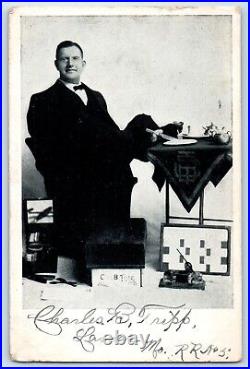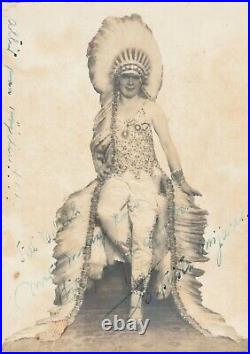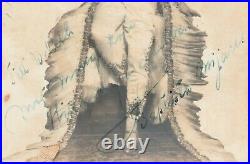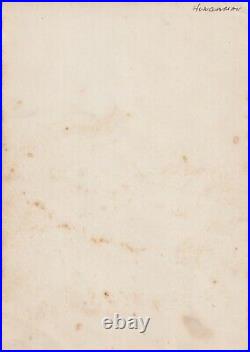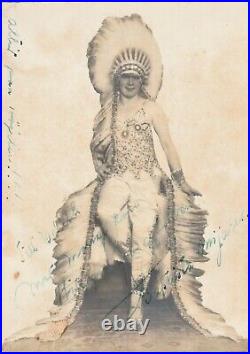
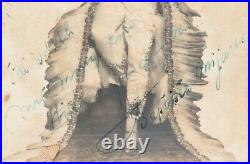

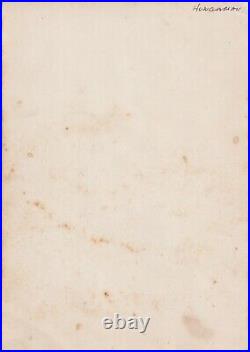

Circus Trainer / Horse Rider / Ring Master / Performer. Ca 1920s – 1930. For offer, a nice old signed photograph! Fresh from a prominent estate in Upstate NY. Never offered on the market until now. Vintage, Old, Original, Antique, NOT a Reproduction – Guaranteed! Baptista is in a glamorous costume. Inscribed and signed in ink. Photo measures 5 x 7 inches. In good to very good condition. If you collect 20th century American photography, performers, circus, Victorian era, oddity, this is a treasure you will not see again! Add this to your image or paper / ephemera collection. Baptista Alfonsine Maria Mijares-Schreiber (April 6, 1886 – October 12, 1956) was a Swedish school rider and circus director. Her father died when she was three years old, and her brother Jean and she began performing in the circus at a young age. Baptista started as a lindanserska at the age of five. From 1909 she was for a year, until she was injured, jockey rider at Cirkus Albert Schumann in Berlin. During and shortly after the First World War, she was a school rider, film actress, cabaret singer and operetta prime minister in Denmark and Sweden. After the war, she began performing with Mexican rapper Chuy Mijares and his brother Manuel. In 1927, together with Chuy Mijares, she started her own Circus Mijares-Schreiber in Sweden, with winter posting in a 1932 built own circus building at Nickkällgatan in Karlskoga. The Mijares brothers performed there for many years in a crowd-hauling winding number. Baptista Schreiber and Chuy Mijares closed their circus in 1952, but restarted a circus for the 1955 season. In Karlskoga her circus horse Menelik is buried next to skogskyrkogården. Baptista A M Mijares-Schreiber. Born:06/04/1886 – Hedvig Eleonora Parish, Stockholm County. Death:12/10/1956 – Karlskoga parish, Örebro County. Circus Director, School Rider. Mijares-Schreiber, Baptista Alfonsine Maria, b 6 April 1886 in Sthlm, Hedv El, d 12 Oct 1956 in Karlskoga. Parents: circus diver Johan Baptist Schreiber and circus diver Berta Ofelia Maria Lindberg. Ran with her husband Chuy M Cirkus in Mijares-Schreiber in Sweden 27-52 o 55. G 1 trol 1912(-25) with singer and actor Conrad Otto Hans Detlefsen, b 27 Nov 1881 in Khvn, Helligånd, d 11 Febr 1963 there, Nathanael, son of båndhandler Conrad Vilhelm Tandrup o Julie Cecilie Charlotte Detlefsen, and adopt (1903) by dental technician Hans Dietrich D; 2 23 July 1927 in Sthlm, Kat, m cirkusdir Jesus (Chuy) Mijares, b 20 Sept 1893 in Monterrey, Mexico, d 5 Oct 1955 in Karlskoga, son of circus diver Arcadio M o Fructuosa Güereque and formerly g m Helena Luise Clarke. Baptista M’s father is said to have been of Austrian origin but was born in Belgium. M was only three years old when he died at the age of only 33, and his passing was a severe blow for the bereaved family. His own circus was already disbanded. M’s mother, who came from a bourgeois family in Sthlm, therefore had no choice but to allow the ten-year-old son Jean to become a breadwinner. He was a good circus rider. Soon it was M’s turn to help with the living. She made her debut at the age of five as a lindanserskaska. Just before the turn of the century, the mother, together with a new life leader, managed to revive the family circus. Together with his brother, M became one of the largest drawcards in different equestrian numbers. M’s great international career began in 1909. She then took up a commitment as a jockey rider – among other things, she was a specialist on various leaps from the mane up on horseback – at Cirkus Albert Schumann in Berlin. A year later, at a performance in Vienna, she injured both legs so badly that she had to stop jockey numbers. In the summer of 1912, they were involved at Cirkus Ciniselli in Khvn. Baptista fell in love with the Danish tenor and actor Otto Detlefsen, who became her first husband. On New Year’s Eve 1913, Siglavy Alda II was mysteriously poisoned and died during a engagement at Cirkus Hagenbeck in London. Dok queen Alexandra’s confidant Lord Lonsdale had been in the circus when the horse died. He decided, after consultation with the Queen, to arrange a gala performance, at which M received a new school horse. The Queen herself was present at this performance. The horse – Menelik – was later suggested to be a personal gift from the Queen of England. The events in London had a great advertising value, which M liked to use, but the First World War brought an unwelcome break in her international circus career. During and shortly after the war, she was a school rider, a film actress, a cabaret singer and an operetta prime minister in Denmark and Sweden. Her husband appeared on and off as a singing cowboy in the school riding number. In the autumn of 1921, the doors were reopened for M’s international career. In Dec of the following year, she was back in London and met there in Bertram Mills Circus the Mexican lindansar brothers Chuy and Manuel Mijares. M and Chuy decided to coordinate their continued engagement, which led to a break with M’s husband. In the spring of 1927, M and her future new husband Chuy Mijares were able to realize an old pipe dream of their own circus, which began its performances in Växjö. From 1932, the company also included a circus building in Karlskoga, where the circus was stationed during the winters. The highlight of the new circus’s program until 1933 was the Mijare brothers’ world-famous lindansar number. Both M and Chuy eventually switched to performing their own freedom horses in the manege. By the end of the 1940s, the spouses’ previously rather modest tent circus had developed into an American giant circus with several manega. The tent measured no less than 68X36 meters. After the 1952 season, M and her husband decided to close their own circus business. Several of their permanent employees had left them in the fall. The following year they instead arranged a Tour of Sweden with the Circus Strassburger, which is based in Holland. In 1955, they started anew as entrepreneurs. It was their last season. M was a master of the art of enthralled her audience whether she rode the higher school, performed her freedom horses or gave speeches in the manege. No one, like her, could have the audience in all of Sweden’s cities believe that their city was particularly close to her heart. M was not only as an artist but also as a business leader one of the greatest in a circus life, and she knew how to create publicity about her business. She was a distinguished animal lover, who never tolerated the slightest neglect when it came to her horses and dogs. M’s husband Chuy M came from a circus family in Mexico and his artist training began at a very young age. With his father as a teacher, he learned the basics of several different circus disciplines, but the exercises soon concentrated on lindans. Chuy M became a specialist in balancing on a 15-meter-long swinging slack line. Word of his achievements soon spread beyond Mexico’s borders and he was first alone and later with his younger brother Manuel, for many years a major attraction at Ringling Bros Circus in the United States. For a few years he also ran together with the French artist Alfred Court Circo Europeo, who toured In Mexico. In the winter of 1922-23, Chuy and Manuel M were engaged with their joint lindansar number Mijares and Brother at Bertram Mills Circus in London. During this engagement they met M. In the summer of 1923, the trio were seen again in Blackpool Tower Circus. Their first joint performance in Sweden took place at Cirkus Schumann in Sthlm in the spring of 1924. The following year, Chuy and Manuel M were once again engaged with Ringling in the United States. The own circus tour, which Chuy and Baptista M started in Sweden in 1927, was intended as a one-off. The first year, however, gave the Swedish tour such high incomes that he realized that it no longer paid to continue as a committed artist. After retiring as a winding man in 1933, he devoted himself mostly to the administration of the circus, but sometimes also performed some of the circus horses in freedom dressing. Chuy M had great personal charisma and pondus that captivated the audience as soon as he appeared in the manege. The art of riding, or the art of riding, has a centuries-old history. It is likely that it began at the same time as man realized that he could tame and use the horse in his work. Equestrian art manifests itself today in several equestrian sports such as dressage, track jumping, off-road riding and hunt seat. Today, baroque riding, also called academic riding, has become popular. It is based on the art of riding described by the great names of the 17th and 18th century, such as Antoine de Pluvinel and François Robichon de la Guérinière. See also the history of the horse. Man tamed the horse 6,000-8,000 years ago, and probably came quite early on that you could ride the horse. The first evidence that man rode the horse and manufactured equipment specifically for that purpose dates from about 700 f. Of the Scythians who lived in ancient Persia. They made simple saddles and bridles. The saddles were usually no more than blankets tied to the horse’s back with ropes. However, there should not have been much knowledge of how the horses move. The first, now known, horse philosopher and trainer to formulate his theories of horse grooming and riding was the field lord and writer Xenophon who lived in ancient Greece, and who is considered one of the founders of classical riding. His book On Horses and Horse Riding is described as the world’s oldest preserved handbook in the art of riding. Later, medieval knights devised new principles of the art of riding, and during the Renaissance it gained real status as one of the art forms and sciences that 16th-century nobles were expected to master. In Italy, the art of riding was developed by the stable masters of Naples, Grisoni and Fiasci. However, their methods were often harsh and cruel. Among other things, Grisoni described an inhumane way to get a sluggish horse to move more forward by tying burning straw to its tail. De la Guérinière served as a knight with the king between 1730 and 1751 where he refined and developed the principles of equestrian art. Among other things, he defined a classic seat that essentially still stands today both for school riding and for regular outdoor riding. His stated goal of making the horse light, calm and obedient so that it is a pleasure to ride in all gaits is equally relevant today. His book École de Cavalerie, published in 1733, illustrated, among other things, the deep and balanced seat. De la Guérinière developed the art of riding into an entire science, saying that “without theory, all practice is meaningless”. He developed exercise programs to increase the horse’s agility and balance and developed the gallop change which today is a common movement in dressage, where the horse switches between right and left gallop. His theories about how to make a horse calm, obedient and easy to learn still apply today. There are several different types of riding styles, arts, depending on where they have been developed, for what purpose they were developed, and which horses were used. The most famous riding schools inspired by the principles of de la Guérinière are the Spanish Riding School in Vienna, Austria, and Cadre Noir in Saumur, France. Less well known and rewritten is the art of riding in the Iberian Peninsula that combined classical riding with practical utility, for example, to drive livestock. Unlike the Spanish Riding School, Cadre Noir has always been a cavalryirid school that has been developed and renewed over the years. However, the Spanish Riding School uses similar pillars (pillars are called each by two in the ground, in riding houses or in the free, knocked-down wooden poles between which a horse can be buckled) [1] used in France in the 17th century. The pillars were a fabrication by the soldier and scientist Antione de Pluvinel who wrote a book of gymnastic exercises and movements that were clearly illustrated by the cartoonist Crispin de Pas. In his book, he used pillars as a benchmark and aid in collecting his horse. The book also included a description of “levad” to which, among other things, the horses at the Spanish Riding School are trained. In The United Kingdom, riding also developed. The two books were praised by the French master rider de la Guérinière. The current equestrian dressage is a classic riding that is rooted in the military’s demand for practical riding from the 19th century until the military’s “de-horse riding” in the mid-20th century. Recently, a classic riding called Baroque riding has started, which has its name from the very time when equestrian art was at its peak in Europe. By then, the importance of the horse in combat had diminished and the riding was seen as an art where the goal was to get his horse moving as beautifully as possible. Riding styles other than the classic used in Europe include western riding in the UNITED STATES, which has evolved from the old cattle work on horseback and the special riding art of the Arabs and Asian equestrian peoples. School riding is the foundation of the art of riding which, through rehearsing and using special movements, intends to give the rider the opportunity to master his horse. The forms of movement of school riding are usually divided into “lower schools” and “higher schools”. School riding, on the other hand, includes non-Spanish walking, falling to the knees and other so-called circus arts. The so-called lower schools of riding include such movements that are normally used in today’s equestrian sports such as sideways movements, backing, sideboard folding and others. The part of riding that intends to bring the horse into higher dressage than is required for use in ordinary riding is referred to as the high or higher school. There is a distinction between schools on and over the ground. Schools on the Ground. The schools on the ground are piaff, passage, pirouette, pesad and lived. The movements except pesad and levad are part of more difficult dressage riding programs and in the Olympic Games. Piaff is a fast-paced, very collected trot under barely discernible movement forward. Passage differs from trotting in that the horse lifts his legs diagonally for a longer period of time than in other types of trot. The movements of the horse during passage are similar to those under the piaff. A pirouette is a U-turn on the back of the combined gallop. Pesad is an artificial stepping ring with an angle of at least 45 degrees whereby the horse carries his entire body weight on the tightly angled hind legs. The front legs should be strongly curved so that the hooves almost touch the elbows. Levad is almost exactly like the pesad. The only difference is that the horse’s rise should be less than 45 degrees. These include the so-called school jumps croupade, courbette, kapriol and ballotad and are now practiced together with pesad and lived only at the Spanish Hovrid school in Vienna and to some extent at the French riding school in Saumur. Croupade is jumping on the spot where the horse’s front and hind legs should be strong and equally curved. Courbette is a movement in which the horse with lowered rear, raised front and strongly curved front legs performs several jumps forward on the hind legs. Honeysuckle is the hardest leap. The leap starts from piaff, the horse is stepped and the hind legs bump away, whereupon the horse is lifted into the air. At its highest point (when the body is horizontal), a powerful backward kick is made. Ballotad is jumping on the spot where the horse’s front and hind legs should be strongly bent and the hind legs’ hooves directed backwards. The most common way to ride today is the classic school ride, also called English riding. It is based on the ancient teachings of the head waiters of France and Great Britain. But there are several different styles to ride in, although all basically evolved from the classic riding. In the galloping sport has used its own style that has been developed through a technique designed to reduce air resistance. In a race, the jockey rides with extremely short trail leather and thus sits high above the horse and leans forward over the horse’s neck. Western riding is rooted in the old herders in the United States during the 18th-19th century. Long days on horseback required a comfortable saddle and not least a comfortable riding style. The western style is thus more relaxed and you sit with your feet slightly in front of the rest of the body and with relatively long trail leather. In classical riding, there are also minor differences. In the dressage, the rider rides on long trail leather to sit down in the saddle even in trot or gallop while a jump rider shortens his trail leather to be able to more easily stand in a field seat over the horse when it jumps. But basically, all kinds of riding art originated from the teachings of Xenophon in ancient times. Federico Caprilli taught a technique in jumping called “il systema” that taught riders to follow the horse’s movements. Caprilli was chief instructor at the Italian cavalry schools and riding in Europe was largely dominated by the riding taught in the army. Caprilli technology meant sitting in a field seat, that is, standing slightly forward in the stirrups with shortened trail leather and following the horse’s leap without disturbing the horse. This was a great contrast to the classic riding art where you rode on long trail leather with almost straight legs, which made you sit deeper in the saddle. The technique was based on an ancient technique used by steppe nods and oriental riders since the horse was domesticated. A circus is a company of performers who put on diverse entertainment shows that may include clowns, acrobats, trained animals, trapeze acts, musicians, dancers, hoopers, tightrope walkers, jugglers, magicians, ventriloquists, and unicyclists as well as other object manipulation and stunt-oriented artists. The term circus also describes the performance which has followed various formats through its 250-year modern history. Although not the inventor of the medium, Philip Astley is credited as the father of the modern circus. In 1768, Astley, a skilled equestrian, began performing exhibitions of trick horse riding in an open field called Ha’Penny Hatch on the south side of the Thames River. [1] In 1770, he hired acrobats, tightrope walkers, jugglers and a clown to fill in the pauses between the equestrian demonstrations and thus chanced on the format which was later named a “circus”. Performances developed significantly over the next fifty years, with large-scale theatrical battle reenactments becoming a significant feature. The traditional format, in which a ringmaster introduces a variety of choreographed acts set to music, developed in the latter part of the 19th century and remained the dominant format until the 1970s. As styles of performance have developed since the time of Astley, so too have the types of venues where these circuses have performed. The earliest modern circuses were performed in open-air structures with limited covered seating. From the late 18th to late 19th century, custom-made circus buildings (often wooden) were built with various types of seating, a centre ring, and sometimes a stage. The traditional large tents commonly known as “big tops” were introduced in the mid-19th century as touring circuses superseded static venues. These tents eventually became the most common venue. Contemporary circuses perform in a variety of venues including tents, theatres and casinos. Many circus performances are still held in a ring, usually 13 m (42 ft) in diameter. This dimension was adopted by Astley in the late 18th century as the minimum diameter that enabled an acrobatic horse rider to stand upright on a cantering horse to perform their tricks. Contemporary circus has been credited with a revival of the circus tradition since the late 1970s, when a number of groups began to experiment with new circus formats and aesthetics, typically avoiding the use of animals to focus exclusively on human artistry. Circuses within the movement have tended to favour a theatrical approach, combining character-driven circus acts with original music in a broad variety of styles to convey complex themes or stories. Contemporary circus continues to develop new variations on the circus tradition while absorbing new skills, techniques, and stylistic influences from other performing arts. This item is in the category “Collectibles\Photographic Images\Photographs”. The seller is “dalebooks” and is located in this country: US. This item can be shipped worldwide.
- Format: Silver gelatin
- Type: Photograph
- Vintage: Yes
- Autograph Authentication: self
- Signed: Yes
- Original/Licensed Reprint: Original
- Signed By: Baptista Mijares-Schreiber
- Time Period Manufactured: Vintage & Antique (Pre-1940)
- Production Technique: Gelatin-Silver Print
- Country/Region of Manufacture: United States
- Material: Paper
- Theme: Circus
- Features: One of a Kind (OOAK)
- Antique: Yes
- Subject: Historic & Vintage, Horse
- Region of Origin: Europe
- Modified Item: No
- Year of Production: 1920
- Size Type/Largest Dimension: Small (Up to 7\
- Listed By: Dealer or Reseller
- Date of Creation: 1920-1929
- Color: Sepia
- Original/Reprint: Original Print

